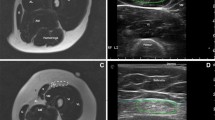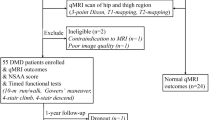Abstract
Background
Prior reports focus primarily on muscle fatty infiltration in Duchenne muscular dystrophy (DMD). However, the significance of muscle edema is uncertain.
Objective
To evaluate the frequency and degree of muscle fat and edema, and correlate these with clinical function.
Materials and methods
Forty-two boys (ages 5–19 years) with DMD underwent pelvic MRI. Axial T1- and fat-suppressed T2-weighted images were evaluated to grade muscle fatty infiltration (0–4) and edema (0–3), respectively. Degree and frequency of disease involvement were compared to clinical evaluations.
Results
Gluteus maximus had the greatest mean fatty infiltration score, followed by adductor magnus and gluteus medius muscles, and had the most frequent and greatest degree of fatty infiltration. Gluteus maximus also had the greatest mean edema score, followed by vastus lateralis and gluteus medius muscles. These muscles had the most frequent edema, although the greatest degree of edema was seen in other muscles. There was correlation between cumulative scores of fatty infiltration and all clinical evaluations (P < 0.05).
Conclusion
In DMD, the muscles with the most frequent fatty infiltration had the greatest degree of fatty infiltration and correlated with patient function. However, the muscles with the most frequent edema were different from those with the greatest degree of edema. Thus, edema may not predict patient functional status.






Similar content being viewed by others
References
Dooley J, Gordon KE, Dodds L et al (2010) Duchenne muscular dystrophy: a 30-year population-based incidence study. Clin Pediatr (Phila) 49:177–179
Monaco AP (1993) Molecular human genetics and the Duchenne/Becker muscular dystrophy gene. Mol Cell Biol Hum Dis Ser 3:1–11
Petrof BJ, Shrager JB, Stedman HH et al (1993) Dystrophin protects the sarcolemma from stresses developed during muscle contraction. Proc Natl Acad Sci USA 90:3710–3714
Mavrogeni S, Papavasiliou A, Spargias K et al (2010) Myocardial inflammation in Duchenne Muscular Dystrophy as a precipitating factor for heart failure: a prospective study. BMC Neurol 10:33
Angelini C (2007) The role of corticosteroids in muscular dystrophy: a critical appraisal. Muscle Nerve 36:424–435
Caskey CT, Ward P, Hejtmancik F (1988) DMD carrier detection and prenatal diagnosis via recombinant DNA methods. Adv Neurol 48:83–91
Marden FA, Connolly AM, Siegel MJ et al (2005) Compositional analysis of muscle in boys with Duchenne muscular dystrophy using MR imaging. Skeletal Radiol 34:140–148
Schreiber A, Smith WL, Ionasescu V et al (1987) Magnetic resonance imaging of children with Duchenne muscular dystrophy. Pediatr Radiol 17:495–497
Sookhoo S, Mackinnon I, Bushby K et al (2007) MRI for the demonstration of subclinical muscle involvement in muscular dystrophy. Clin Radiol 62:160–165
Gong QY, Phoenix J, Kemp GJ et al (2000) Estimation of body composition in muscular dystrophy by MRI and stereology. J Magn Reson Imaging 12:467–475
Kim HK, Laor T, Horn PS et al (2010) T2 mapping in Duchenne muscular dystrophy: distribution of disease activity and correlation with clinical assessments. Radiology 255:899–908
Liu GC, Jong YJ, Chiang CH et al (1993) Duchenne muscular dystrophy: MR grading system with functional correlation. Radiology 186:475–480
Swinyard CA, Deaver GG, Greenspan L (1957) Gradients of functional ability of importance in rehabilitation of patients with progressive muscular and neuromuscular diseases. Arch Phys Med Rehabil 38:574–579
Tannus A, Garwood M (1997) Adiabatic pulses. NMR Biomed 10:423–434
Mercuri E, Pichiecchio A, Allsop J et al (2007) Muscle MRI in inherited neuromuscular disorders: past, present, and future. J Magn Reson Imaging 25:433–440
Carlo B, Roberta P, Roberto S et al (2006) Limb-girdle muscular dystrophies type 2A and 2B: clinical and radiological aspects. Basic Appl Myol 16:17–25
May DA, Disler DG, Jones EA et al (2000) Abnormal signal intensity in skeletal muscle at MR imaging: patterns, pearls, and pitfalls. Radiographics 20:S295–S315
Kim HK, Laor T, Horn PS et al (2010) Quantitative assessment of the T2 relaxation time of the gluteus muscles in children with Duchenne muscular dystrophy: a comparative study before and after steroid treatment. Korean J Radiol 11:304–311
Wren TA, Bluml S, Tseng-Ong L et al (2008) Three-point technique of fat quantification of muscle tissue as a marker of disease progression in Duchenne muscular dystrophy: preliminary study. AJR Am J Roentgenol 190:W8–W12
Mengiardi B, Schmid MR, Boos N et al (2006) Fat content of lumbar paraspinal muscles in patients with chronic low back pain and in asymptomatic volunteers: quantification with MR spectroscopy. Radiology 240:786–792
McDouall RM, Dunn MJ, Dubowitz V (1990) Nature of the mononuclear infiltrate and the mechanism of muscle damage in juvenile dermatomyositis and Duchenne muscular dystrophy. J Neurol Sci 99:199–217
Baron D, Magot A, Ramstein G et al (2011) Immune response and mitochondrial metabolism are commonly deregulated in DMD and aging skeletal muscle. PLoS One 6:e26952
Jaramillo D, Laor T (2008) Pediatric musculoskeletal MRI: basic principles to optimize success. Pediatr Radiol 38:379–391
Straub V, Donahue KM, Allamand V et al (2000) Contrast agent-enhanced magnetic resonance imaging of skeletal muscle damage in animal models of muscular dystrophy. Magn Reson Med 44:655–659
Schmidt S, Vieweger A, Obst M et al (2009) Dysferlin-deficient muscular dystrophy: gadofluorine M suitability at MR imaging in a mouse model. Radiology 250:87–94
Acknowledgments
This research project was supported by RSNA seed grant (The Fujifilm Medical System RSNA Research Seed Grant 2010–2011) and SPR seed grant 2009–2010.
Conflicts of interest
None
Author information
Authors and Affiliations
Corresponding author
Rights and permissions
About this article
Cite this article
Kim, H.K., Merrow, A.C., Shiraj, S. et al. Analysis of fatty infiltration and inflammation of the pelvic and thigh muscles in boys with Duchenne muscular dystrophy (DMD): grading of disease involvement on MR imaging and correlation with clinical assessments. Pediatr Radiol 43, 1327–1335 (2013). https://doi.org/10.1007/s00247-013-2696-z
Received:
Revised:
Accepted:
Published:
Issue Date:
DOI: https://doi.org/10.1007/s00247-013-2696-z




